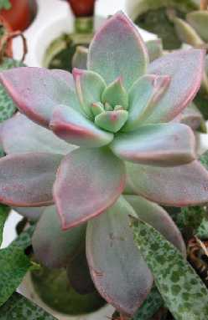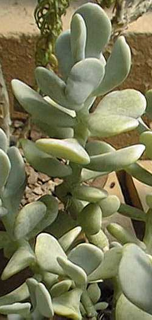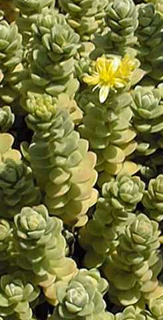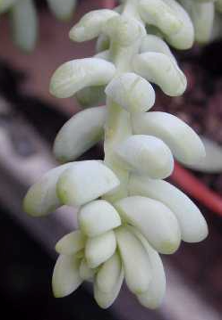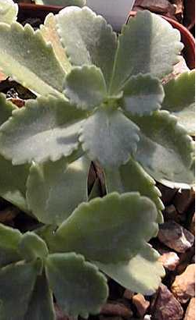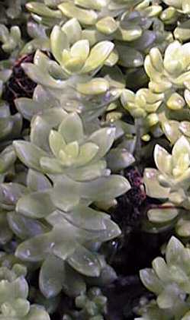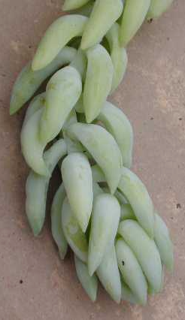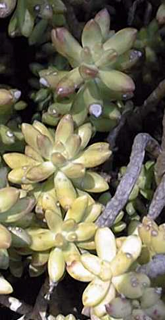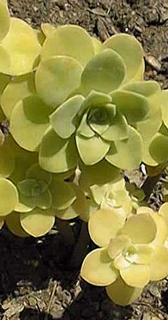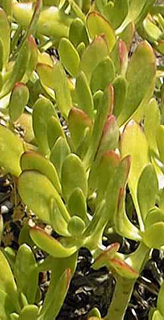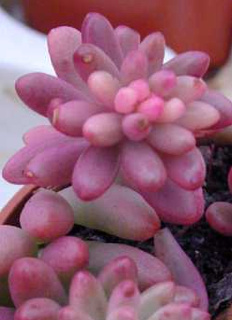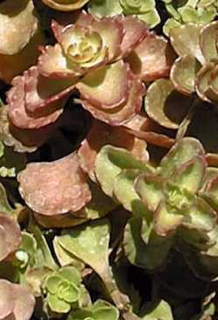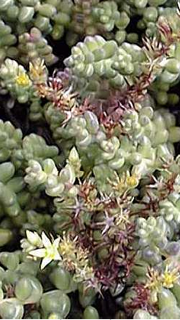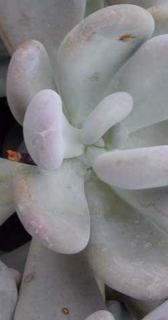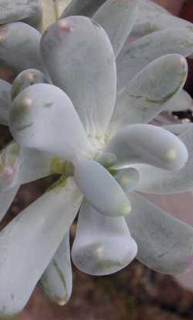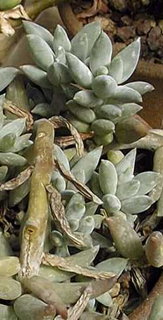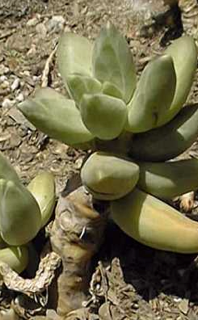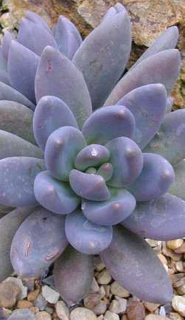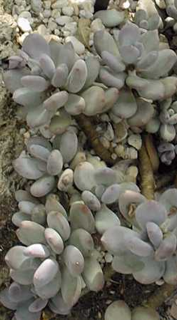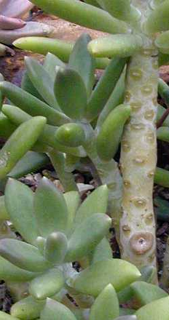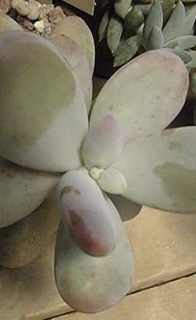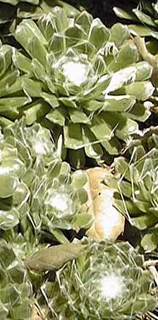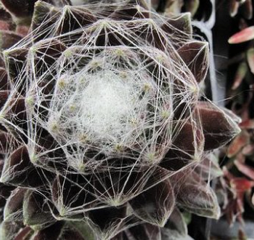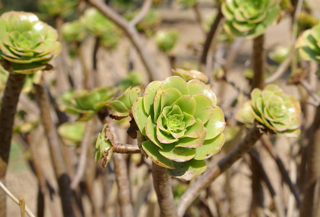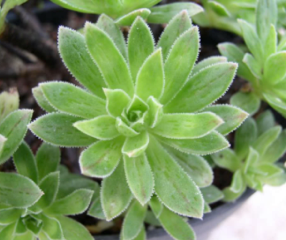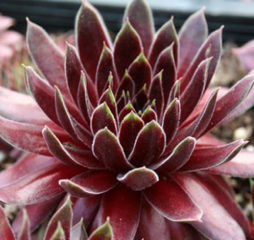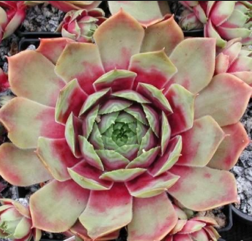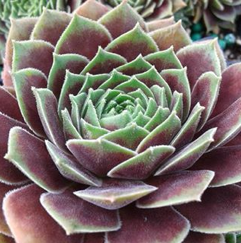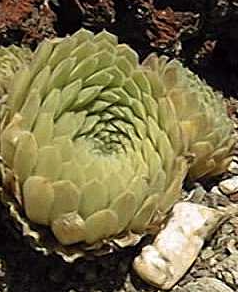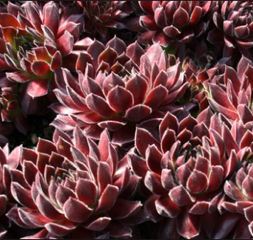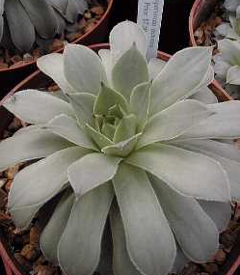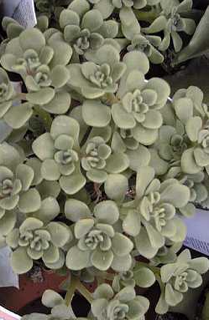Submitted by: Jim Tanner
Contents: Sedum, Pachyphytum, Sempervivum, LATIN LOOKUP
Sedum is a wonderful genus. It contains miniatures from the Italian Alps, ground covers from Japan, tree-like specimens from Mexico, Echeveria impostors and little weedy things from all over. Most are easily grown, many are tolerant of extreme cold, and are as much a part of the rock gardening and alpine plant communities as they are the cactus and succulent world. There are few plants that can withstand out-and-out abuse better than some of the small ground-hugging Sedum.
Many of the smaller Sedums make excellent ground cover. These plants are often available in flats or six-packs at nurseries that specialize in landscape plants. They are not often seen in small pots, although they make excellent pot specimens, accents for a dish garden or drapes for hanging planters. When well staged, many are trophy table competitors at all of our local shows.
Sedum is one of the genera of Crassulaceae, with over 400 species. The plants are mostly northern hemisphere plants, with significant endemic groups in East Asia, North America and Europe/West Asia. There are about 120 Mexican Sedums. In general, Sedum can be identified by opposite leaves and five- pointed flowers; however, there are numerous exceptions here as well.
Sedums are apparently in active evolution, with many “near Sedums” in very closely related genera. The genus as a whole is still poorly studied and explored.
Sedum booleanum from Nuevo León is one of the smallest-leaved interesting species. This is a recently described species, first appearing in 1996. The leaves are opposite, forming a neat, white, cruciform head when viewed from above. It branches freely and is easily grown. This plant is just coming into cultivation, and is still hard to find.
All of the woody species want excellent drainage, with nearly pure pumice providing the best growth conditions, as long as they are kept fertilized and frequently watered in the summer months.
Tom Glavich
Pachyphytum is a genus containing about a dozen of Mexican species of succulents related to Echeveria. The main attraction of these species are the softly colored leaves, generally covered with a powdery bloom. The genus name Pachyphytum comes from the Greek for ‘thick leaves’.
The flowers are small, not very interesting. They are followed by tiny seed pods. The Pachyphytum are generally propagated by leaf cuttings.
Pachyphytum tend to be more resistant to extreme temperature than Echeveria, they can generally bear 20°F (-7°C) for short periods, and tend to be more heat resistant.
Sempervivum is a genus of about 40 species of flowering plants in the Crassulaceae family. Common names include liveforever and hen and chicks, a name shared with plants of other genera as well. They are succulent perennials forming mats composed of tufted leaves in rosettes. In favorable conditions they spread rapidly via offsets, and several species are valued in cultivation as groundcover for dry, sunny locations.
Sempervivum exist from Morocco to Iran, through the mountains of Iberia, the Alps, Carpathians, Balkan mountains, Turkey, the Armenian mountains, in the northeastern part of the Sahara Desert, and the Caucasus. Their ability to store water in their thick leaves allows them to live on sunny rocks and stony places in the mountain, subalpine and alpine belts. Most are hardy to US zone 4, and will handle warm climates to about zone 8.
The name Sempervivum has its origin in the Latin semper (“always”) and vivus (“living”), because this perennial plant keeps its leaves in winter and is very resistant to difficult conditions of growth. The common name “houseleek” is believed to stem from the traditional practice of growing plants on the roofs of houses to ward off fire and lightning strikes.
Sempervivum grow as tufts of perennial but monocarpic rosettes. Each rosette propagates asexually by lateral rosettes (offsets, “hen and chicks”), by splitting of the rosette or sexually by tiny seeds.
Typically, each plant grows for several years before flowering. Their hermaphrodite flowers have first a male stage. Then the stamens curve themselves and spread away from the carpels at the center of the flower, so self-pollination is rather difficult. The color of the flowers is reddish, yellowish, pinkish, or (seldom) whitish. After flowering, the plant dies, usually leaving many offsets it has produced during its life.
The meanings of latin plant names on this page – from http://davesgarden.com/guides/botanary/
- adolphii [ad-OL-fee-eye]
Named for Adolphe-Thodore Brongniart, 19th century French botanist and scientist; a founder of modern paleobotany, he helped prove that pollen existed. - arachnoideum [a-rak-NOY-dee-um]
Spider’s web. - australe [aw-STRAL-ee]
Of or from the south, or Australia. - balsamiferum [bal-sam-EE-fer-um]
With a fragrant wax, resin. - bracteosum [brak-tee-OH-sum]
Bract-bearing. - burrito [bur-REE-toh]
Spanish diminutive of burro (donkey). - caespitosum [kess-pi-TOH-sum]
Tufted. - clavifolia [klav-ih-FOH-lee-uh]
Club leaved. - coeruleum [ko-er-OO-lee-um]
Blue colored. - compactum [kom-PAK-tum]
Compact. - ellacombeanum [el-la-komb-ee-AH-num]
Named for Henry Nicholson Ellacombe, early 20th century gardener at Bicton Rectory (now Avon). - glutinicaule [gloo-tin-ih-KAW-lee]
Sticky stem. - longifolium [lon-jee-FOH-lee-um]
Long leaves. - lucidum [loo-sid-um]
Bright, clear, lustrous. - morganianum [mor-gan-ee-AY-num]
Named for Dr. Meredith Morgan, who first grew the species. - nussbaumerianum [nuss-baw-mer-ee-AH-nuh]
Named for Nussbaumer. - oviferum [oh-VEE-fer-um]
Egg-bearing. - Pachyphytum [pak-ee-FY-tum]
Thick plant. - palmeri [PALM-er-ee]
Named for Ernest Jesse Palmer, 20th century English-born American explorer and plant collector. - praealtum [pray-AL-tum]
Very tall. - rubrotinctum [roo-broh-TINK-tum]
Red-dyed, because the leaves turn red in full sun. - Sedum [SEE-dum]
Sedentary, to sit. - Sempervivum [sem-per-VEE-vum]
Always living, living forever. - spurium [SPUR-ee-um]
False. - stahlii [STAHL-ee-eye]
Named for Christian Ernst Stahl, 19th century German botanist and professor at Jena. - tectorum [tek-TOR-um, TEK-tor-um]
Referring to roof. - tortuosum [tor-tew-OH-sum]
Twisted.
